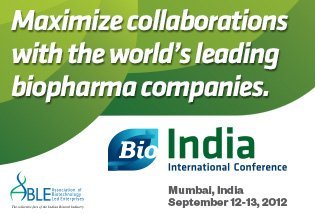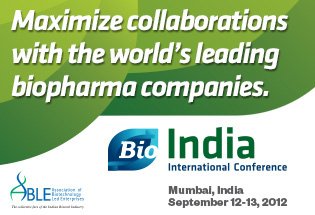
Last month, I had a chance to attend the Bio India International conference. Bio India 2012 co-hosted by the Association of Biotechnology Led Enterprises (ABLE), a national forum that represents the Indian Biotechnology Sector and the Biotechnology Industry Organization (BIO) in Mumbai brought together biotech and pharma companies from North America, EU and Asia to meet, discuss common issues and explore business opportunities.
 The conference opened with a Biopharma regulatory and policy roundtable discussion. The participating industries agreed that strong IP protection is presents a big incentive to innovate and issuance of indiscriminate compulsory licenses based on cost alone is incorrect. Other hot issues such as the need for guidelines pertaining to biologics, drug approval processes and the need for defined comparability exercise* were highlighted.
The conference opened with a Biopharma regulatory and policy roundtable discussion. The participating industries agreed that strong IP protection is presents a big incentive to innovate and issuance of indiscriminate compulsory licenses based on cost alone is incorrect. Other hot issues such as the need for guidelines pertaining to biologics, drug approval processes and the need for defined comparability exercise* were highlighted.
In a keynote session Kiran Mazumdar-Shaw, Chairman & Managing Director of Biocon, H. Thomas Watkins, Former President & CEO, Human Genome Sciences brought innovations, best practices, management strategies to run a company and the changing face of biotech industry to the fore. She suggested resource sharing and partnered innovation as strategies to keep drug development costs to a minimum given that that investment spends, failure, post marketing risks, time for development and clinical trial costs are increasing. “Synriam”, an anti-malarial drug approved first in India is a case in point. Rashmi Barbhaiya, CEO & Managing Director of Advinus Therapeutics Inc brought to fore how the drug was developed by Ranbaxy under a budget of $30 m! Synriam consists of short acting drug Arterolane maleate in combination with the long acting Piperaquine phosphate. Artemisinin has till date been obtained from plant source which results in high costs and inability to scale up supply in face of sudden demand. Arterolane however is a new chemical entity which overcomes scale up and cost problems. Treatment cost to the patient is Rs. 130 (1). With Synriam, not only has India joined a select group of nations capable of developing their own drugs; but has been able to do so by keeping costs of drug development and price to the patient low.
India being the world’s larges manufacturer of vaccines, Dr. Cyrus Poonawalla, Founder, Chairman, and Managing Director, Serum Institute of India Ltd. was invited for a fireside chat on vaccine development in India. With 1 in 2 vaccines administered across the world being developed by Serum Institute and presence in 140 countries, it is a perfect example of growth simply by relying on product strengths — very low cost and high quality instead of advertisements. In conjunction with the Gates Foundation, Serum has been able to bring down costs of meningitis vaccine from $3/dose to 40¢/dose; a boon to 80,000 + meningitis patients (2, 3). It offers both long term protection and can be administered to children, who are most likely to be affected. Serum’s business has been both profitable and humane. With philanthropic intentions, Serum has managed to keep costs extremely low. This has deterred both, the big Pharma and new entrants from entering the vaccine market. Their growth has been by numbers e.g. scaling up measles vaccines from 32m to 400m doses. Serum’s success highlights the ability of Indian vaccine makes to make high-quality vaccines available at affordable prices.
In the session on “Commercializing Stem Cell Therapies and Regenerative Medicine”; challenges in developing stem cell therapies to treat disease conditions, market challenges, affordability, production technology and need for distinct regulatory policies were discussed. To develop a global product and grab a share in the $680 m global market, stem cell therapies would have to be treated differently from Pharma products, be developed in conjunction with doctors and made accessible and affordable to patients.
In the final session on “India’s Global Role in Innovation”; good management and working strategies adopted by big Pharma to startups, role of Government in fostering innovation across academia and industry, funding support, lifecycle management of biotech/Pharma products and how to leverage these in order to succeed were discussed.
In addition to India focused panel discussions and keynote talks, the conference offered networking opportunities by way of one-on-one partnering sessions, hosted receptions and company presentations. Thus, Bio India 2012 provided a unique platform to extend one’s business, make new contacts, foster collaboration and discuss common industry issues and spread awareness of mechanisms in place to ensure success.
From an agrarian and manufacturing economy, India is moving to be a knowledge based economy in which both Bio and IT economies have a big role to play. Sam Pitroda, Advisor to the Prime Minister of India on Public Information Infrastructure & Innovations in his address touched upon the role of bio sector for growth in India. Apart from healthcare which improves the quality of life, Bio economy also has the potential to confer food, environment and energy independence. With the world‘s largest population of hungry people, usage of GM crops becomes inevitable. 200m tones of biomass can be utilized to reach the target of using 20% alcohol in fuel helping absolve a part of dependence on oil import which currently stands at 80%.
2010 – 2020 being India’s “Decade of Innovation” (4), we must charter our own paths for achieving inclusive growth**.
- http://www.financialexpress.com/news/ranbaxy-s-indigeneous-antimalaria-drug-to-come-at-rs.-130/941481/
- http://globalhealth.kff.org/Daily-Reports/2010/July/01/GH-070110-Meningitis-Vaccine.aspx?p=1
- http://www.landesbioscience.com/journals/vaccines/News-PolicyHV6‑8.pdf?nocache=1888202475
- http://www.dst.gov.in/whats_new/press-release10/pib_10‑3 – 2010.htm
Comparability exercise* — Demonstration that a subsequent entry biologics (think of generics in small molecule drugs) has similar quality, safety and efficacy compared to a reference biologic drug
Inclusive growth** — Economic advancement of all economic strata of the society including those below poverty line.